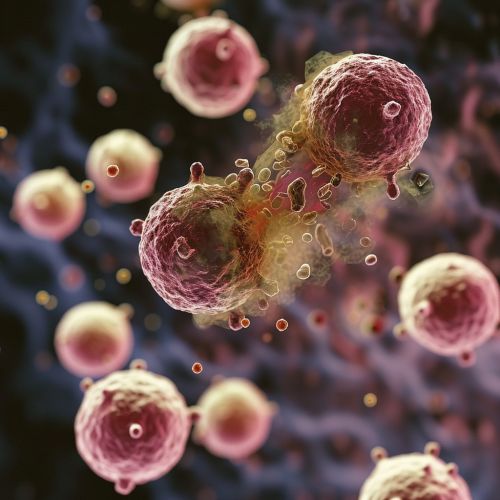Cytokine storm
Overview
A Cytokine storm is a severe immune reaction in which the body releases too many cytokines into the blood too quickly. Cytokines are small proteins that play important roles in cell signaling. They are produced by a broad range of cells, including immune cells like macrophages, B lymphocytes, T lymphocytes, and mast cells, as well as endothelial cells, fibroblasts, and various stromal cells. A cytokine storm can occur as a result of an infection, autoimmune condition, or other diseases. It is a life-threatening situation and is believed to be the cause of severe complications, such as multiple organ failure, associated with some diseases.


Causes
Cytokine storms can result from a variety of factors. They are most commonly triggered by severe infections, such as influenza, pneumonia, sepsis, and more recently, COVID-19. However, they can also be caused by certain drugs, autoimmune diseases, and cancers. In some cases, cytokine storms are the result of a genetic predisposition.
Pathophysiology
The pathophysiology of a cytokine storm is complex and involves a cascade of immune reactions. When the immune system is fighting an infection, it produces cytokines to help coordinate the body's response. However, in some cases, this response can become uncontrolled, leading to the release of a flood of cytokines. This overproduction of cytokines can cause a variety of symptoms, including fever, inflammation, severe fatigue, and nausea. If not controlled, a cytokine storm can lead to more serious complications, such as acute respiratory distress syndrome (ARDS) and multiple organ failure.
Symptoms
The symptoms of a cytokine storm are severe and often include high fever, swelling and redness, extreme fatigue, and nausea. Other symptoms can include a rapid heartbeat, difficulty breathing, a rash, and changes in mental function. In severe cases, a cytokine storm can lead to life-threatening complications, such as multiple organ failure.
Diagnosis
Diagnosing a cytokine storm can be challenging, as the symptoms are similar to those of many other conditions. However, certain laboratory tests can help in the diagnosis. These tests measure the levels of various cytokines in the blood. High levels of certain cytokines, such as interleukin-6 (IL-6), can indicate a cytokine storm. Other tests, such as a complete blood count, liver function tests, and coagulation tests, can also help in the diagnosis.
Treatment
Treatment for a cytokine storm is primarily supportive and aims to manage the symptoms while the body fights off the infection. This can include the use of medications to reduce inflammation and suppress the immune response, such as corticosteroids. In severe cases, hospitalization may be required, and intensive care may be needed to support organ function.
Prevention
Preventing a cytokine storm involves managing the conditions that can trigger it. This includes treating infections promptly and effectively, managing autoimmune diseases, and monitoring the use of certain medications. In some cases, prophylactic use of certain drugs may be recommended for individuals at high risk of a cytokine storm.
